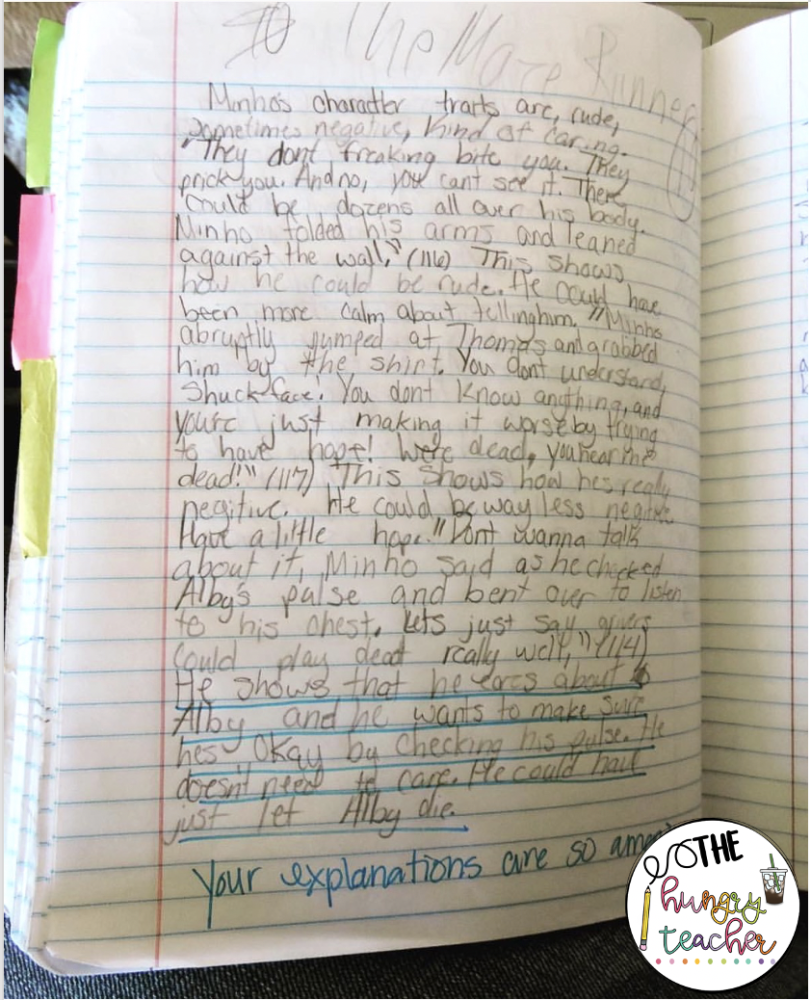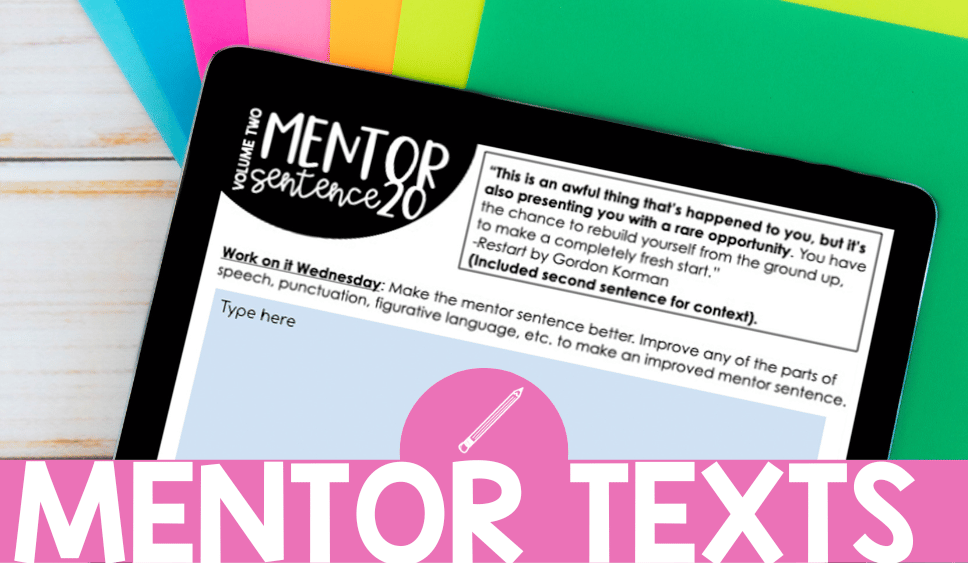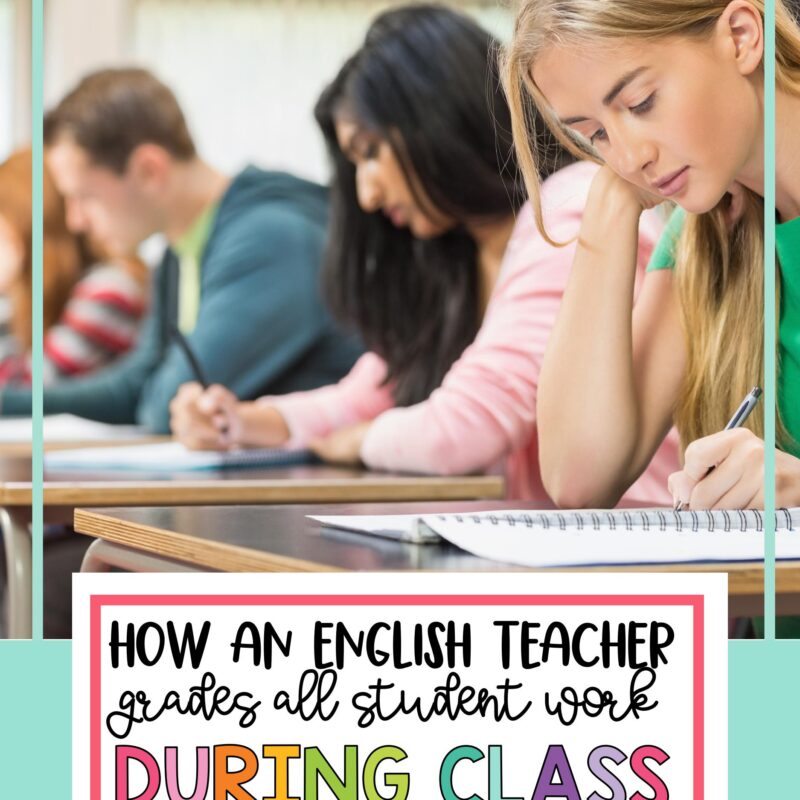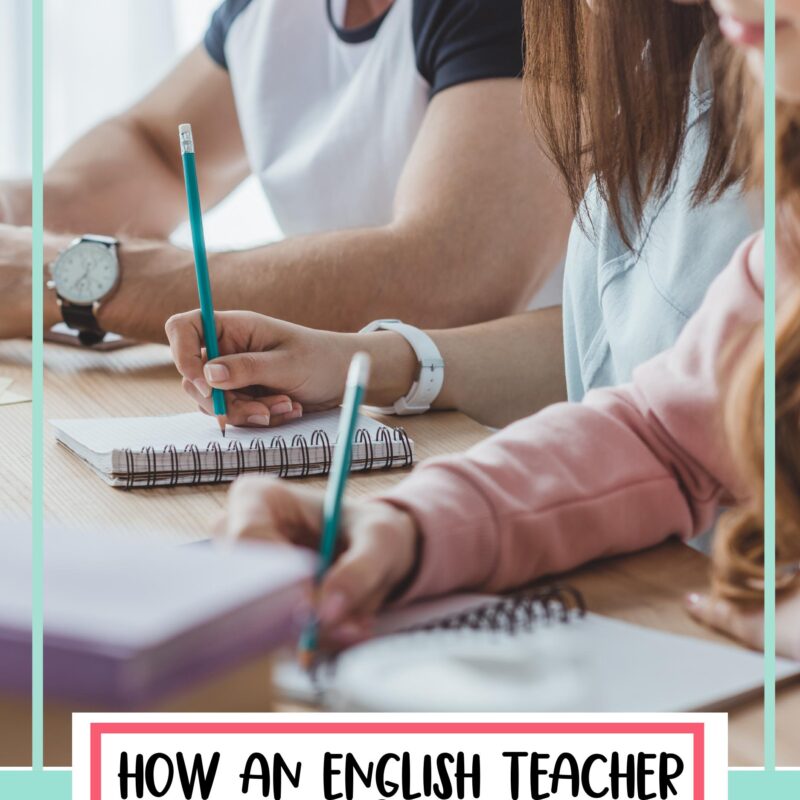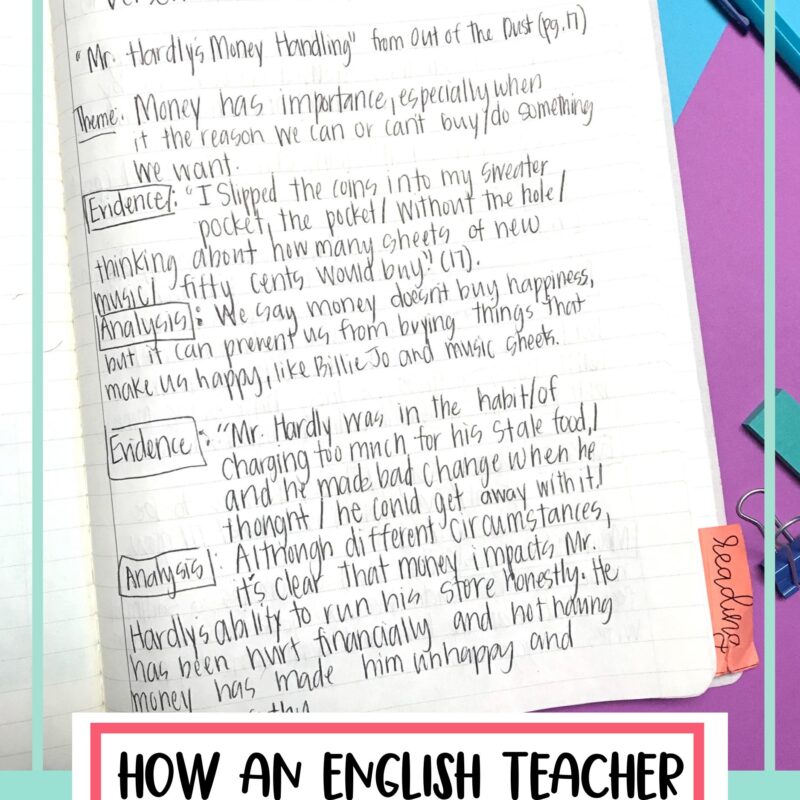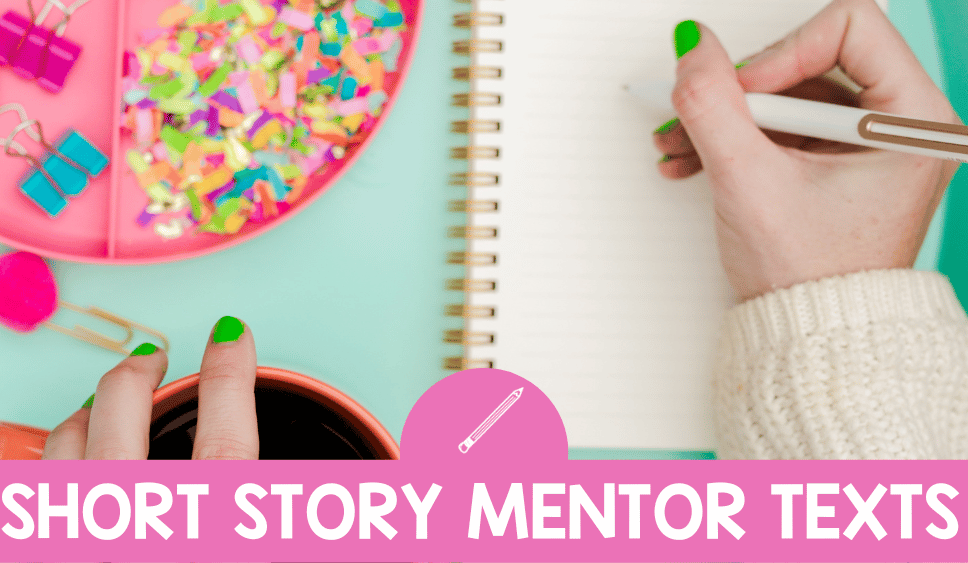
The One Thing I Do To Keep My Grading Down as a Middle School English Teacher
One of the biggest adjustments I had to learn going from upper elementary to middle school ELA was how not to kill myself with grading English essays and just writing in general, but also still give 100 middle schoolers feedback on their work (specifically writing). I have A LOT of tricks I’ve learned (I will talk about them) but there is ONE THING that you need to start doing if you want to have a life again. Ready for this?
If you’ve been following me for awhile then you know that I have had a kind of unconventional path in my teaching profession. I got my bachelor’s degree in K-6 elementary, thinking that 6th graders were terrifying. So I spent three years in 5th grade, one year in 6th, and by some crazy events ended up teaching middle school English Language Arts to 7th and 8th graders.
I LOVE middle school ELA. I obviously had to make some adjustments, but now I can’t see me doing anything else.
So what’s the trick?
GRADE ALMOST ALL OF IT RIGHT THEN AND THERE IN CLASS.
Yes, I’m still talking to you English teachers. It is possible to get all your grading done in class.
Okay, so how do I do this?
I promise it’s actually not that hard, and yes I have pretty normal class sizes. My six different classes have about 24 students, so in total I have about 150ish students.
It’s easiest to just give you like a step-by-step of how it looks when I give an assignment and then grade it right there in class. Kind of like a script, if you will.
HOW TO GIVE FEEDBACK TO ALL OF YOUR STUDENTS IN ONE CLASS PERIOD
- This works with almost any type of grading for writing and reading responses. Whether, we have just done a read aloud, a whole class novel, they have just read a short story, a poem, an excerpt, books clubs, literature circles… whatever. If they have read something, and you want to assess their writing and their analysis/reading response, this strategy works
- After we have read or students come to class having read the night before, I am looking to assess them on some type of literature or informational concept we’re learning, while also giving them feedback on their writing and analysis of the text.
- So I will say something like, “Write 3/4 of a page to 1 page about what themes you see (provide evidence) in this section of the novel (or in this short story or poem, etc.)

SETTING STUDENTS UP TO COMPLETE THEIR WORK IN CLASS
- This is where you have to set it up so they can get it done and you can get them all graded in class.
- I have a 65 minute class period (but I used to have 55 and still did this) and in 7th grade I expect them to be able to write 3/4 of a page in 20 minutes and expect at least one page from my 8th graders in this same amount of time.
- BUT I do give them and myself some cushion time because we read for the last 15-20 minutes of every single one of my ELA class periods.
- I will say, “You have 20-25 minutes to write your response. When you are done, bring it up to me and I will grade it. If it is not acceptable, I will ask that you go back and adjust until it is. When you have been graded by me, then you may read silently.”
- They have 20-25 minutes, but really, they have 35-40 because I am including that reading time. So if they do’t get done in the original time, or I send them back, it give them that time to write and it also creates more time for me to grade.

ADAPTING GRADING FOR STUDENTS NEEDS AND BEHAVIORS
- Some students finish quality work in 10-15 minutes time. When they’re done, they come up to me and I grade it. The first students done are usually the strongest or the laziest writers (just keeping it real). I can quickly read the strong writers’ responses. Once you get good at it, you know to just look for them restating the question, their actual answer, and proof of evidence.
- My lazier writers tend to be “done” quickly too (or at least think they’re done). These students often don’t have text evidence (because it requires to much effort) so I automatically look for it, then tell them to go back and provide evidence for their answer. (I have modeled how to do this, so they’re not blindly trying to figure it out, but if they still struggle, I ask other students if they’re willing to help them do it correctly).
- Then students just slowly trickle up to me and form short lines to be graded. I can give them immediate feedback verbally:
COMMON FEEDBACK I PROVIDE TO STUDENTS
- Here are some of my most often used phrases.
- I do a lot of questioning as well to get them to try and figure out where they went wrong (especially in middle school because they REALLY need to be doing analysis almost all the time) and hopefully they go back and learn/fix it themselves:
- “Great use of textual evidence to support your theme.”
- “Love how you’re thinking beyond the text to determine the theme of this story.”
- “You did a great job of making it clear on how your evidence supports your answers for the themes of the text.”
- “Good job correctly citing the author and page number in MLA format.”
- “You need to go back and provide evidence. Look for something on pages ____ to help you support your answer.”
- “I see a lot of spelling and capitalization errors. Go back and fix those and then come up here and try again.”
- “What do you always need to do for books titles (short story titles, poems, etc.)? Go back and fix then and then try again.”
- “Remind me what theme means? Okay, so I think you need to go back and write more of a theme than a summary of the book. Look at what you wrote, and then see if you can write about a lesson we can learn from it.”
GETTING STUDENTS TO APPLY TEACHER FEEDBACK IMMEDIATELY
This feedback HAS TO BE USED IMMEDIATELY because they want the grade, so it’s win-win. They’re getting feedback from you and they’re ACTUALLY USING IT. WHAT!?
While I am grading, I just have a clipboard with a class roster so I can make notes of students who are REALLY struggling. Then the next time we write, I go check with them first so I can get them started. Simple notes like, “spelling, capitalization, analysis vs. summary, evidence” let me know what they struggle with for next time.
When I grade, I grade one of two ways and most kids get As and Bs because I make them go back until it’s quality work. They HATE it, but it quickly teaches them to do it right the first time.
I simply just grade it for a simple grade out of 20 points or so. If they have all the components, then they get the full 20 and I just write 20/20 on the assignment. When they have to go back to make it higher quality they can still get an A. If they fix multiple times, but still just aren’t getting it, then it will be a 16/20 or 14/20. I keep going until all students’ assignments are graded.
USING RUBRICS TO ASSESS STUDENT READING RESPONSES
The other way I grade, is by using these editable rubrics. If I know we are going to do a response, I will just print a stack of them (sometimes I do two or four to a page and cut them) and grab one for each student as they come up.
I made them editable so that I can delete the rows or columns that I don’t want to assess that day. There are multiple rubrics included now because over the years I have made more and more based on what I’ve realized I’ve wanted to assess my students.
Sometimes I want to just grade for text evidence. Other times I am looking for evidence, their ability to write argumentatively, and on spelling. I use the mixture rubric the most (pictured above, but sometimes I am very specific and us on of the other one).
Depending on how many points I want the assignment to be worth, I will assign points for each category. Then I can quickly fill in how many they got on each section and give them a total points grade. I sometimes ask students to go write their strength and goal on the lines, or if I do take extra time to grade a response, I will write what their strengths and goals are.
EDITABLE RUBRICS FOR EACH GRADE LEVEL
- MIDDLE SCHOOL EDITABLE READING RESPONSE RUBRICS
- SIXTH GRADE EDITABLE READING RESPONSE RUBRICS
- FIFTH GRADE EDITABLE READING RESPONSE RUBRICS
- FOURTH GRADE EDITABLE READING RESPONSE RUBRICS
- EIGHTH GRADE EDITABLE LITERATURE RUBRICS
- SEVENTH GRADE EDITABLE LITERATURE RUBRICS
- SIXTH GRADE EDITABLE LITERATURE RUBRICS
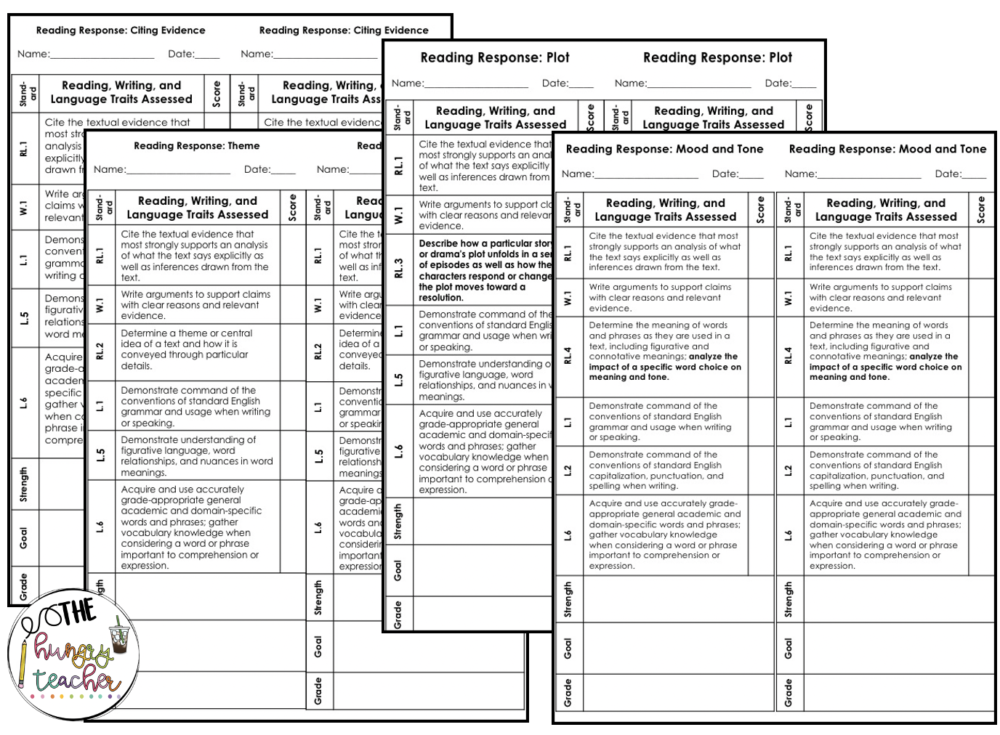
FREQUENTLY ASKED QUESTIONS ABOUT THIS GRADING STRATEGY
QUESTION ONE:
What about students who can’t write as much as you’re requiring during this time.
ANSWER: I obviously have students with IEPs where writing as much as I require in the time frame, is just not possible. I am flexible. I give them more time, or shorten how much I expect, or grade for quality and not quantity. I’ve never had an issues with most of them finishing, unless they fall into the category I will answer in the next question.
QUESTION TWO:
What about the kids who won’t write or who say stuff like, “Can’t I just get a C or D on it and be done?
ANSWER: I am known for showing my students what type of work they are capable of doing. Many go beyond what they expect even of themselves. I am not however, known for tolerating laziness. I HATE IT. Some honestly sit there the whole time doing nothing, and then I tell them they have homework at the end of class, and I will check it tomorrow. Students hate when this happens because everyone else gets done, and already have a grade for it.
Kids who are willing to take the “bad grade” so they can be done? #sorrynotsorry, it’s not happening. Again, I am known as the “easy class” but I think that’s solely based on the fact that I don’t give homework. They know I will make them go back 10 million times to make it quality. Watching everyone else get a grade and get to move on eventually frustrates them into just doing it right. When kids are capable, I will push them until they prove it.
QUESTION THREE:
What do you do when you have a big line of kids waiting?
ANSWER: Easy! I make them write their name on the board (in order) and then tell them to go read while I grade. Then I just call them up as I get to them. That way we don’t waste time and they get more reading time!
QUESTION FOUR:
QUESTION: What about kids who don’t finish?
ANSWER: It becomes homework. I have maybe one or two students per class period who I make do this. If they are working hard, but don’t finish, I will grade what they have. This strategy helps high stress kids and perfectionists calm down. If they mess around, they will have homework until it’s quality work.
READING RESPONSE FREEBIE
If you want to try out some rubrics for free, check out the freebie here or on the image below. If you are already a subscriber, then these rubrics are in your free resource library.
Share it:
Email
Facebook
Pinterest
Twitter
- Read more about: Middle School ELA Assessment, Middle School Writing, Organization

